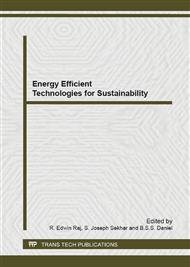[1]
S.S. Murthy B.P. Singh, C. Nagamani and K.V.V. Satynarayana, Studies of the conventional induction motor as self-excited induction generators, IEEE Transaction On Energy Conversion, 3, (1988) 842 - 848.
DOI: 10.1109/60.9360
Google Scholar
[2]
G. Raina and O. P. Malik, Wind energy conversion using a self-excited induction generator, IEEE Trans. Power App. Syst., 102(1983) 3933-3936.
DOI: 10.1109/tpas.1983.317933
Google Scholar
[3]
N. P. A. Smith, For stand induction generators alone micro-hydro systems, IEEE proceeding, of International conference on Power Electronics, drives and Energy System For Industrial Growth, (1996) 669-673.
DOI: 10.1109/pedes.1996.535860
Google Scholar
[4]
C. F. Wanger, Self-excitation of induction motors, AIEE Trans., 58 (1939) 47-51.
Google Scholar
[5]
Basset E. D and Potter F. M., Capacitive excitation for induction generators, AIEEE committee of Electrical Engineering, (1935) 535-545.
Google Scholar
[6]
Elder J. M., Boys J. T and Woodward J. L., The process of self excitation in induction generators, IEE Proc. 130 (1983) 103-108.
DOI: 10.1049/ip-b.1983.0016
Google Scholar
[7]
Lahcene Quazene and George McPherson, Analysis of the isolated induction generator, IEEE Transaction on power apparatus and systems, 102(1983) 2793-2798.
DOI: 10.1109/tpas.1983.317962
Google Scholar
[8]
R. C. Bansal, Three-phase self-excited induction generators: over view, IEEE Transaction on Energy Conversion, 20 (2005) 292 -299.
DOI: 10.1109/tec.2004.842395
Google Scholar
[9]
Yogesh K., Chauhan, Sanjay K. Jain, and Bhim Singh, A prospective on voltage regulation of self-excited induction generators for industry applications, IEEE Transactionss on Industry Applications, 46 (2010) 720-730.
DOI: 10.1109/tia.2009.2039984
Google Scholar
[10]
S. S. Murthy, Bhim Singh, Ashish Kulkarni, R. Sivarajan and Sushma Gupta, Field eperiences on a novel pico-hydel system using self-excited induction generator and electronic load controller, IEEE proceeding 842 – 847.
DOI: 10.1109/peds.2003.1283076
Google Scholar
[11]
S. S. Murthy, Rini jose and Bhim Singh, A practical load controller for stand alone small hydro system using Self- Excited Induction Generator, IEEE Proceeding (1998) 359-364.
DOI: 10.1109/pedes.1998.1330042
Google Scholar
[12]
Bhim Singh, S. S. Murthy and Sushma Gupta, Modeling of STATCOM based voltage regulator for self-excited induction generator with dynamic loads, IEEE Conference Proc.
DOI: 10.1109/iecon.2003.1280069
Google Scholar
[13]
Malik N. H., Al-Bahrani, A. H. Influence of the terminal capacitor on the performance characteristics of a self- excited induction generator, IEE Proc., 137(1990)168-173.
DOI: 10.1049/ip-c.1990.0022
Google Scholar
[14]
J. K. Chatterjee, B.M. Doshi and K.K. Ray, A new method for thyristor phase controlled VAr compensator, IEEE/PES winter meeting 89(1989).
Google Scholar
[15]
R. Bonert and S. Rajakaruna, Self-excited induction generator with excellent voltage and frequency control, IEE Proceeding Generation, Transmission & Distribution, 145(1998)31-39.
DOI: 10.1049/ip-gtd:19981680
Google Scholar
[16]
R. Bonert and G. Hoops, Stand alone induction generator with terminal impedance controller and no turbine controls, IEEE/PES (1989) 28-32.
DOI: 10.1109/60.50808
Google Scholar
[17]
Bhim Singh, S. S. Murthy and Sushma Gupta, Analysis and design of electronic load controller for self-excited induction generators, IEEE Trans. on Energy Conv., 21(2006) 285-293.
DOI: 10.1109/tec.2005.847950
Google Scholar
[18]
Raul Rabinovici, Autonomous excitation of induction generators, IEEE Trans. on Magnetics, 34 (1998) 664-670.
DOI: 10.1109/20.668063
Google Scholar
[19]
Raul Rabinovici and Natan Ben-Hai, Starting oscillations of an autonomous induction generator, IEEE Trans. on Magnetics, 35(1999).
DOI: 10.1109/20.800590
Google Scholar
[20]
J.K. Chatterjee, B. Venkatesa Permual and Naveen Reddy Gopu, Analysis of operation of self-excited induction generator with generalised impedance controller, IEEE Transactions on Energy Conversion, 22 (2006) 307- 315.
DOI: 10.1109/tec.2006.875432
Google Scholar
[21]
F.A. Farret, B. Palle and M.G. Simoes, Full expandable model of sef-excited induction generators, IEE Proc. Electr. Power. App. 152 (2005) 96-102.
DOI: 10.1049/ip-epa:20045057
Google Scholar
[22]
Andrew miller, Edward Muljadi, Donald S. Zinger, A variable speed widturbine power control", IEEE Transactions on Energy Conversion, 12 (1997) 181-186.
DOI: 10.1109/60.629701
Google Scholar
[23]
Mat lab/Simulink Software Version. 9. 0.
Google Scholar


